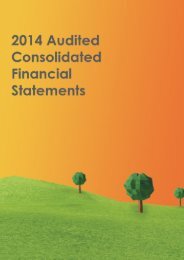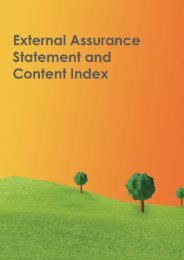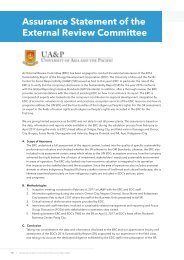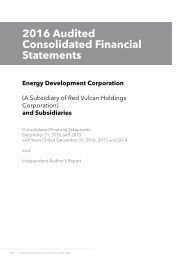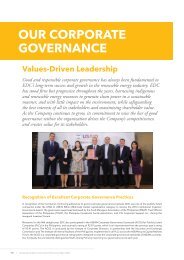EDC 2014 SR (UPDATED)
You also want an ePaper? Increase the reach of your titles
YUMPU automatically turns print PDFs into web optimized ePapers that Google loves.
<strong>EDC</strong> <strong>2014</strong> Performance Report<br />
HTM Investments<br />
HTM investments are quoted non-derivative financial assets with fixed or determinable payments<br />
and fixed maturities for which the Company has the positive intention and ability to hold to<br />
maturity. Where the Company sells other than an insignificant amount of HTM investments, the<br />
entire category would be tainted and would have to be reclassified as AFS investments.<br />
Furthermore, the Company would be prohibited to classify any financial assets as HTM<br />
investments for the following two years. After initial measurement, HTM investments are<br />
measured at amortized cost using the effective interest method. Amortized cost is calculated by<br />
taking into account any discount or premium on acquisition and fees that are integral parts of the<br />
effective interest rate. Gains and losses are recognized in the consolidated statement of income<br />
when the HTM investments are derecognized or impaired, as well as through the amortization<br />
process. The effect of restatement of foreign-currency denominated HTM investments are also<br />
recognized in the consolidated statement of income.<br />
The Company has no HTM investments as of December 31, <strong>2014</strong> and 2013.<br />
Loans and Receivables<br />
Loans and receivables are non-derivative financial assets with fixed or determinable payments that<br />
are not quoted in an active market. After initial measurement, loans and receivables are carried at<br />
amortized cost using the effective interest method less any allowance for impairment. Gains and<br />
losses are recognized in the consolidated statement of income when the loans and receivables are<br />
derecognized or impaired, as well as through the amortization process.<br />
Loans and receivables are classified as current assets if maturity is within 12 months from the<br />
financial reporting date. Otherwise, these are classified as noncurrent assets.<br />
Classified under loans and receivables are cash and cash equivalents, trade and other receivables,<br />
and long-term receivables (see Notes 7, 8, 15 and 31).<br />
AFS Investments<br />
AFS investments are those non-derivative financial assets that are designated as such or are not<br />
classified as financial assets designated at FVPL, HTM investments or loans and receivables.<br />
They are purchased and held indefinitely, and may be sold in response to liquidity requirements or<br />
changes in market conditions.<br />
After initial measurement, AFS investments are subsequently measured at fair value with<br />
unrealized gains and losses being recognized as other comprehensive income in the “Net<br />
accumulated unrealized gain (loss) on AFS investment” account until the investment is disposed<br />
of or is determined to be impaired, at which time the cumulative gain or loss previously<br />
recognized in equity are recognized in the consolidated statement of income. The Company uses<br />
the specific identification method in determining the cost of securities sold. Interest earned on the<br />
investments is reported as interest income using the effective interest rate method. Dividends<br />
earned on investment are recognized in the consolidated statement of income when the right to<br />
receive payment has been established.<br />
AFS investments are classified as current if these are expected to be realized within 12 months<br />
from the financial reporting date. Otherwise, these are classified as noncurrent assets.<br />
AFS investments include quoted investments in government securities, corporate bonds,<br />
proprietary and equity shares (see Notes 9 and 31).<br />
169




